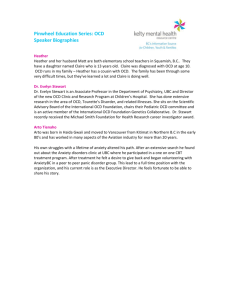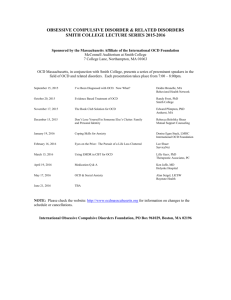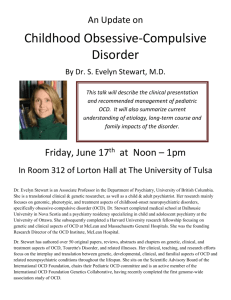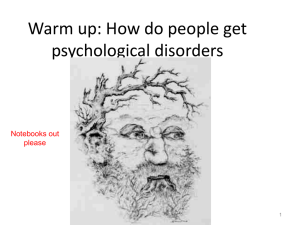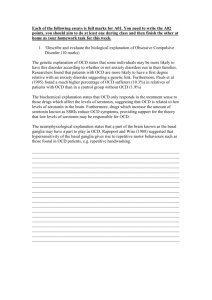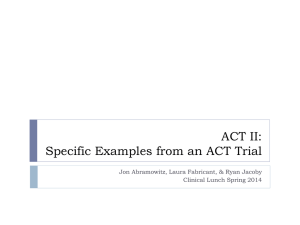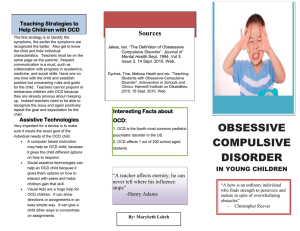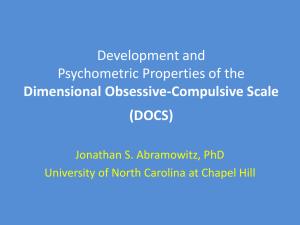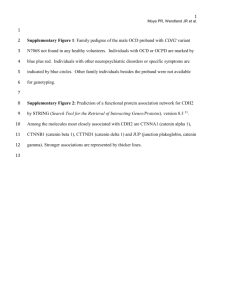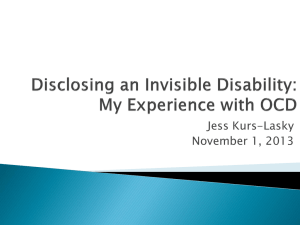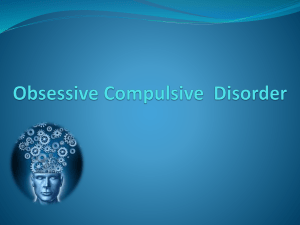OCD 2011
advertisement
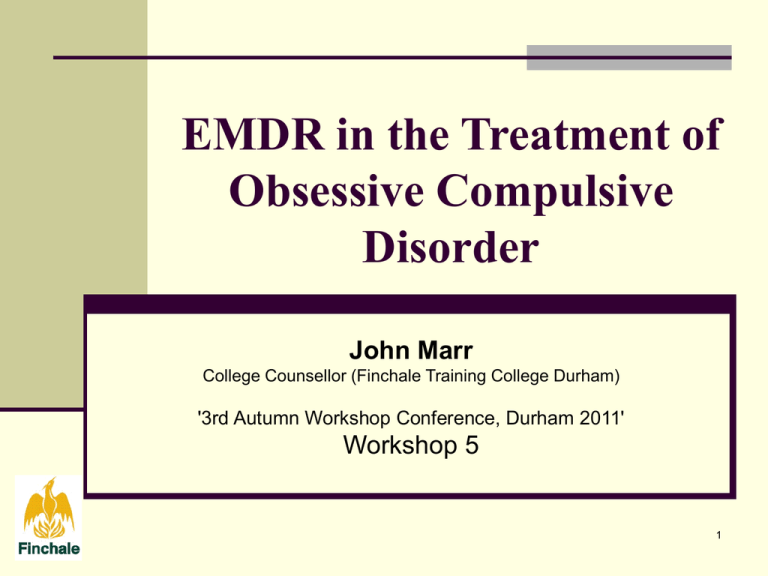
EMDR in the Treatment of Obsessive Compulsive Disorder John Marr College Counsellor (Finchale Training College Durham) '3rd Autumn Workshop Conference, Durham 2011' Workshop 5 1 AGENDA 20 Minutes Background Explanation on method and reason developed 20 Minutes Practicum Think of a small ‘t’ OCD event 10 minutes Question and Answer 2 OCD Clients who could not engage with CBT Exposure Response Therapy The World Health Organisation has listed OCD in the top 10 most disabling illnesses in the world. Although Ex/RP therapy can be highly effective for around 50% of people who complete Ex/RP treatment there are a number of recognized drawbacks. (Psychological Medicine, 40, pp 2013-2023) 3 Recognized Drawbacks Ex/RP therapy involves the individual facing their worst fears; many individuals are unable to complete treatment as a result. Ex/RP therapy can be hard work and will require the completion of homework between sessions. Ex/RP therapy may not be effective for individuals who experience obsessions without compulsions. Psychological Medicine, 40, pp 2013-2023 4 De Silver & Marks, 1999 suggest that there is a causal link between the onset of OCD and a traumatic event in the clients life that still has a direct affect upon the clients symptomatology. Dr Robin Logie 2011 has also been working with the use of ‘neat’ EMDR on the treatment of OCD, and he will be providing a presentation later today. Robin also noted that the future template was a vital part of the treatment process. One of the biggest problems with Ex/RP is the relapse rate which is high (57.3%) and which hasn't improved in past 20 years. World Health Organization; Global Burden of Disease 2000, Draft 21-08-06; Maher et al. 2010 5 What are the options Continue with EX/RP therapy Medicate Do Nothing Discover the causal link Be Innovative 6 My Option Use a combination of the Phobia Protocol and Mental Video Playback A standard Phobia Protocol with exceptions Mental Video Playback replaces EX/RP EMDR reprocess the response to the mental exposure 7 Demonstration During the history taking identify the OCD Triggers Electric Plugs Taps Touching People Water Locking Doors Infection ETC 8 Mental Video Playback Teach self-control procedures to handle the “fear of fear” Working on each trigger to start Which of the identified triggers would you like to work on today? I want you to play a mental video of the “first, worst, last” time this happened. (I use the last) As you play the video if you feel any stress stop the video and let me know. 9 When the client experiences stress and stops use a basic protocol. Image Emotion Bodily sensation You can take a SUD’s for reference Process as normal Check SUD’s for evidence of change When change is satisfactory, have client return to the Mental Video Playback and continue playback until the next stress is experienced. 10 Past Memories Target and reprocess the following: Antecedent or ancillary events that contribute to the OCD The first time the OCD was experienced The most disturbing experiences The most recent time it was experienced Present Triggers Any associated present stimuli The physical sensations or other manifestations of OCD, fear or unrest, including hyperventilation Future Template Incorporate a positive template for OCD -free future action (as mentioned in a recent article by Dr Robin Logie) Arrange contract for action Run mental videotape of full sequence and reprocess disturbance Complete reprocessing of targets revealed between sessions To use the full Protocol, all 6 steps should be included 11 Y-BOCS (session 1 – 6) 40 35 30 25 20 15 10 5 0 6 12 Y-BOCS (session 1 – 14) 40 35 30 25 20 15 10 5 0 6 14 13 Y-BOCS (session 1 – 14) session 30 follow up 40 35 30 25 20 15 10 5 0 0 6 14 30 Weeks 14 Feedback I think that this paper will make a strong and very important contribution to the literature. This is the first successful treatment of OCD and you have come at it in an innovative and effective direction. Congratulations! It’s wonderful. Louise Maxfield; London Health Sciences Centre; University of Western Ontario and Lakehead University; London ON Canada 15
